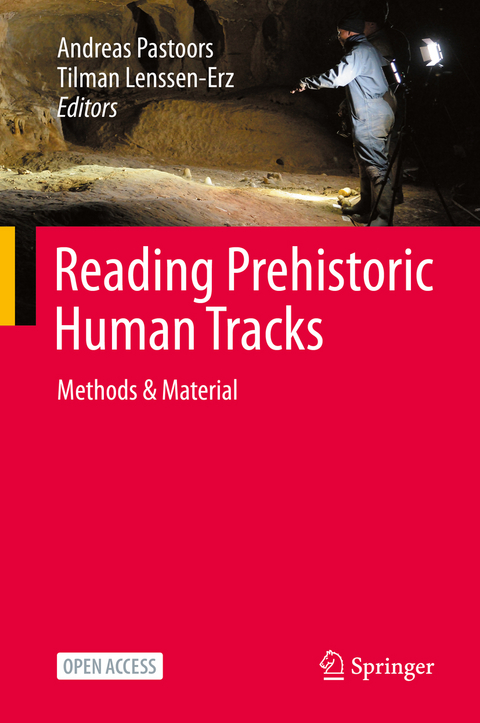
Reading Prehistoric Human Tracks
Springer International Publishing (Verlag)
978-3-030-60405-9 (ISBN)
This Open Access book explains that after long periods of prehistoric research in which the importance of the archaeological as well as the natural context of rock art has been constantly underestimated, research has now begun to take this context into focus for documentation, analysis, interpretation and understanding. Human footprints are prominent among the long-time under-researched features of the context in caves with rock art. In order to compensate for this neglect an innovative research program has been established several years ago that focuses on the merging of indigenous knowledge and western archaeological science for the benefit of both sides.
The book gathers first the methodological diversity in the analysis of human tracks. Here major representatives of anthropological, statistical and traditional approaches feature the multi-layered methods available for the analysis of human tracks. Second it compiles case studies from around the globe of prehistoric human tracks. For the first time, the most important sites which have been found worldwide are published in a single publication. The third focus of this book is on firsthand experiences of researchers with indigenous tracking experts from around the globe, expounding on how archaeological sciencecan benefit from the ancestral knowledge.
This book will be of interest to professional archaeologists, graduate students, ecologists, cultural anthropologists and laypeople, especially those focussing on hunting-gathering and pastoralist communities and who appreciate indigenous knowledge.
lt;p>Andreas Pastoors studied Prehistoric Archaeology and from there he successfully researched questions concerning the Middle Palaeolithic and the Upper Palaeolithic art. Since the late 1980s he has been working in the Volp Caves (Tuc d'Audoubert, Les Trois-Frères and Enlène), which are outstanding testimonials worldwide. Today he is the research director in these caves.
Since 2015 he is working at the FAU in Erlangen-Nuremberg as a lecturer and researcher. Among the many excavations and research projects he has led, the co-leadership of the project combining indigenous knowledge with archaeology, "Tracking in Caves" is notable.He publishes his research promptly, which has led not only to a rapid dissemination of the results, but also to an impressive list of publications. In addition to many articles in high-ranking international journals, he has also repeatedly published monographs, which are still considered "great" works within the discipline, since they deal intensively with a specific topic. In addition to his dissertation and habilitation, the genre of sustainable publications, which will certainly retain their value decades after their publication, includes the three fundamental books on the Volp Caves which he co-edited, as well as a number of other conference proceedings published under his direction.
Tilman Lenssen-Erz has a background in African Studies and in Prehistoric Archaeology from which he developed a specialization in African rock art, particularly in Namibia and the Eastern Sahara. Since 1986 he is head of rock art research at the African Archaeology at the University of Cologne, since 2012 he leads the open online African Archaeology Archive Cologne. Besides projects in research data management he is also co-leader of two projects combining indigenous knowledge with archaeology, "Tracking in Caves" and "Indigenous Knowledge and Archaeoinformatics". His research always aims at cooperation with and training of local communities for capacity building.
He has published widely on rock art research with a focus on theoretical and methodological aspects, but also compiling and editing the unique six-tomed catalogue series "The Rock Paintings of the Upper Brandberg".
lt;p>Chapter 1. Introduction (Andreas Pastoors and Tilman Lenssen-Erz).- Part I: Methodological Diversity in the Analysis of Human Tracks.- Chapter 2. Inferences from Footprints: Archaeological Best-Practice (Matthew R. Bennett and Sally C. Reynolds).- Chapter 3. Repetition without Repetition: A comparison of the Laetoli G1, Ileret, Namibian Holocene and Modern Human footprints using Pedobarographic Statistical Parametric Mapping (Juliet McClymont and Robin H. Crompton).- Chapter 4. Reproduce to Understand: Experimental Approach based on Footprints in Cussac Cave (Southwestern France) (Lysianna Ledoux, Gilles Berillon, Nathalie Fourment and Jacques Jaubert).- Chapter 5. Experimental Re-Creation of the Depositional Context in which Late Pleistocene Tracks were found on the Pacific Coast of Canada (Duncan McLaren, Quentin Mackie and Daryl Fedje).- Chapter 6. Reading Spoor: Epistemic Aspects of Indigenous Knowledge and its Implications for the Archaeology of Prehistoric Human Tracks (Tilman Lenssen-Erz and Andreas Pastoors).- Part II: Case Studies from Around the Globe.- Chapter 7. Perspectives on Pliocene and Pleistocene Pedal Patterns and Protection: Implications for Footprints (Erik Trinkaus, Tea Jashashvili and Biren Patel).- Chapter 8. Frozen in the Ashes: The 3.66-million-year-old Hominin Footprints from Laetoli, Tanzania (Marco Cherin, Angelo Barili, Giovanni Boschian, Elgidius B. Ichumbaki, Dawid A. Iurino, Fidelis T. Masao, Sofia Menconero, Jacopo Moggi Cecchi, Susanna Sarmati, Nicola Santopuoli and Giorgio Manzi).- Chapter 9. Steps from History: The Happisburgh Footprints and their Connections with the Past (Nick Ashton).- Chapter 10. Reconsideration of the Antiquity of the Middle Palaeolithic Footprints from Theopetra Cave (Thessaly, Greece) (Nina Kyparissi-Apostolika and Sotiris K. Manolis).- Chapter 11. On the Tracks of Neandertals: The Ichnological Assemblage from Le Rozel (Normandy, France) (Jérémy Duveau, Gilles Berillon, Christine Verna, Gilles Laisné and Dominique Cliquet).- Chapter 12. Hominin Footprints in Caves from Romanian Carpathians (Bogdan P. Onac, Daniel S. Veres and Chris Stringer).- Chapter 13. Episodes of Magdalenian Hunter-Gatherers in the Upper Gallery of Tuc d'Audoubert (Ariège, France) (Andreas Pastoors, Tilman Lenssen-Erz, Tsamgao Ciqae, /Ui Kxunta, Thui Thao, Robert Bégouën and Thorsten Uthmeier).- Chapter 14. Following the Father Steps in the Bowels of the Earth: The Ichnological Record from the Bàsura Cave (Upper Palaeolithic, Italy) (Marco Avanzini, Isabella Salvador, Elisabetta Starnini, Daniele Arobba, Rosanna Caramiello, Marco Romano, Paolo Citton, Ivano Rellini, Marco Firpo, Marta Zunino and Fabio Negrino).- Chapter 15. Prehistoric Speleological Exploration in the Cave of Aldène in Cesseras (Hérault, France): Human Footprint Paths and Lighting Management (Philippe Galant, Paul Ambert ( ) and Albert Colomer ( )).- Chapter 16. The Mesolithic Footprints retained in one Bed of the Former Saltmarshes at Formby Point, Sefton Coast, North-West England (Alison Burns).- Chapter 17. Prehistoric Human Tracks in Ojo Guareña Cave System (Burgos, Spain): The Sala and Galerías de las Huellas (Ana I. Ortega, Francisco Ruiz, Miguel A. Martín, Alfonso Benito-Calvo, Luis Bermejo and Theodoros Karampaglidis).- Part III: Experiences with Indigenous Experts.- Chapter 18. Tracking with Batek Hunter-Gatherers of Malaysia (Lye Tuck-Po).- Chapter 19. Identify, Search and Monitor by Tracks: Elements of Analysis of Pastoral Know-How in Saharan-Sahelian Societies (Laurent Gagnol).- Chapter 20. Trackers' Consensual Talk: Precise Data for Archaeology (Megan Biesele).- Chapter 21. An Echo from a Footprint: A Step too Far (Steve Webb).- Chapter 22. Walking Together: Ways of Collaboration in Western-Indigenous Research on Footprints (Hannah Zwischenberger).
| Erscheinungsdatum | 02.03.2021 |
|---|---|
| Zusatzinfo | XIII, 436 p. 126 illus., 101 illus. in color. |
| Verlagsort | Cham |
| Sprache | englisch |
| Maße | 155 x 235 mm |
| Gewicht | 959 g |
| Themenwelt | Geisteswissenschaften ► Archäologie |
| Geschichte ► Allgemeine Geschichte ► Altertum / Antike | |
| Sozialwissenschaften ► Ethnologie | |
| Schlagworte | Footprints in caves with rock art. • Indigenous trackers from around the globe • open access • Pleistocene human footprints • Scientific value of prehistoric human footprints • Tracking in Caves |
| ISBN-10 | 3-030-60405-5 / 3030604055 |
| ISBN-13 | 978-3-030-60405-9 / 9783030604059 |
| Zustand | Neuware |
| Haben Sie eine Frage zum Produkt? |
aus dem Bereich


